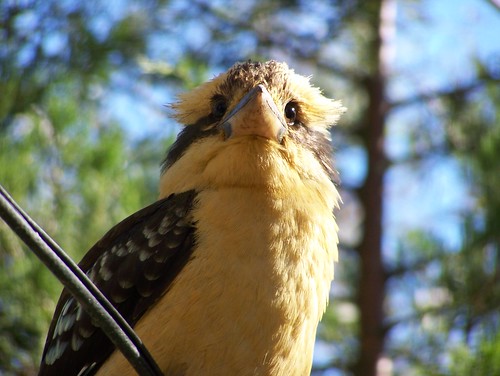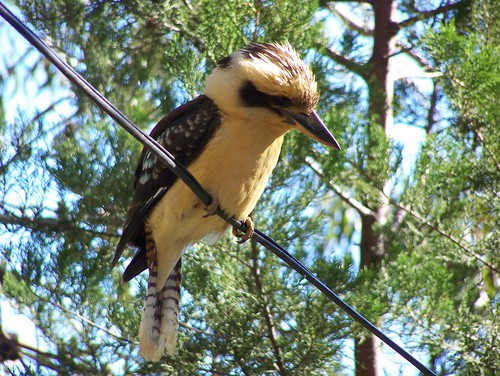
Also from my 2006 trip, this is a Laughing Kookaburra, one of four kookaburra species, and the only one in the Sydney region.
Kookaburras are related to the little fellow I posted just below: They're members of kingfisher family, but while the one featured below is a river kingfisher, the kookaburra is a tree kingfisher. They're carnivores, too, but rather than fish they eat insects, worms, crustaceans, reptiles, frogs, snakes, mice, and even chicks of other birds.
They are most famous for their call, which begins at our place right around 4:15 every morning:
According to an Aboriginal legend, the kookaburra's famous chorus of laughter every morning is a signal for the sky people to light the great fire that illuminates and warms the earth by day. The legend captures the imagination, but the true function of the familiar cacophony is to advertise the territory of this bold bird. The Laughing Kookaburra is the largest of the kingfisher family, but unlike most of its relatives, it is sedentary and occupies the same territories the year round.This site says that early European settlers described the call "appalling as the ravings of a madman . . . and ends in a prolonged sardonic chuckle."
Here's an example, but without the characteristic "hoo hoo hoo" start. This is just a raspy call.
The same site says this:
The name kookaburra is derived from an Aboriginal name, similar to the onomatopoeic words from other Aboriginal languages, including akkaburra, googooburra, gurgara, gingara and arkooburra.More:
Laughing Kookaburras are believed to pair for life. The nest is a bare chamber in a naturally occurring tree hollow or in a burrow excavated in an arboreal (tree-dwelling) termite mound. Both sexes share the incubation duties and both care for the young. Other Laughing Kookaburras, usually offspring of the previous one to two years, act as 'helpers' during the breeding season. Every bird in the group shares all parenting duties.I actually saw one emerge from a termite nest on a tree once. Thought it was a little cream-colored rodent at first, then off it flew. Here's a photo of a termite mound on a tree with holes that were likely once entrances to a kookaburra nest:
The Laughing Kookaburra.


It's always nice to hear the kingfisher "cackle" as they fly up and down Ashland Creek. Aside from it being a distinctive and unusual call, it's a good sign that the fish in the creek are safe to eat. No kingfishers is a bad sign for the creek.
ReplyDelete